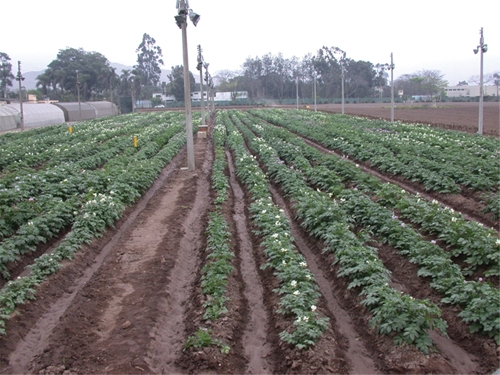
Features
Agronomy
Traits and Genetics
Genetic diversity: better potatoes
“Making steady progress” is how researcher Dr. David De Koeyer describes his work on identifying genes from South American wild and landrace potatoes. The genetic material he studies could improve varieties grown in Canada, in particular, better resistance to diseases and pests and enhanced nutrition.
June 13, 2013 By Rosalie I. Tennison
 Field plots at the International Potato Center in Lima “Making steady progress” is how researcher Dr. David De Koeyer describes his work on identifying genes from South American wild and landrace potatoes. The genetic material he studies could improve varieties grown in Canada
Field plots at the International Potato Center in Lima “Making steady progress” is how researcher Dr. David De Koeyer describes his work on identifying genes from South American wild and landrace potatoes. The genetic material he studies could improve varieties grown in CanadaAfter spending several months in Peru examining some of the improved potato germplasm at the International Potato Center (CIP) in Lima, Dr. De Koeyer is now back in Canada at the Potato Research Centre in Fredericton examining the genes he identified for their usefulness in Canadian breeding programs. Meanwhile, his Peruvian colleagues are continuing some of the research he initiated to provide additional agronomic data for the study.
“The material we are most interested in exists in Peru where there is a vast array of diversity, but transferring what we have identified to northern climates is difficult,” Dr. De Koeyer explains. Potato varieties from the tropical climates grow under shorter daylight periods, he explains, and when they are transferred to Canada to long-day conditions, the tropical varieties rarely set tubers. However, these varieties have a wealth of genetic material that could enhance northern breeds.
Dr. De Koeyer is taking two approaches to the research. Firstly, he is attempting to identify late blight resistance in the South American varieties that can be transferred into Canadian breeding material quicker. Secondly, he is hoping to identify other traits that are desirable in Canadian varieties and select them while eliminating any negative genes.
“We will be able to improve our varieties faster, if we can isolate the genetic material that we want to use,” explains Dr. De Koeyer. “In the long term we want to develop varieties that will be disease resistant and have good agronomic values.
The knowledge we are gaining from this research will speed up our breeding process.”
The challenge is finding the desired genes without also transferring the genetic material that affects maturity. Certainly, Canadian growers want to take advantage of long day conditions, but they want the tubers to set within the short Canadian growing season.
“We have one of the shortest growing seasons for potato production in the world,” Dr. De Koeyer admits. Therefore, identifying useful traits and getting them into germplasm suited to the Canadian growing season is his main objective. “My goal is to create a faster process of potato improvement. My hope is that this research into the potato genome will be embraced by growers and industry once we have developed the tools to make the breeding process faster while adding beneficial traits.”
Dr. De Koeyer’s research will have benefits reaching beyond Canada’s borders. By identifying the genes for improved quality and performance, the breeding process can be faster and some of the genetic material that is identified can be used to improve potato varieties in other parts of the world. According to Dr. De Koeyer, his department’s collaborative efforts with CIP will lead to development of varieties based on physiological and DNA marker selection that could improve the food supply in the developing world.
Genetic diversity is the key to variety development to express specific traits in potatoes from improving quality to ensuring
timely maturity. Dr. De Koeyer’s work to identify the genes that control performance of varieties and those that effect quality will result in growers having some of the best varieties in the world growing successfully under Canadian conditions.
Print this page